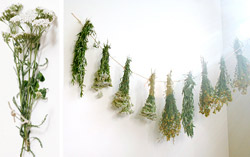 Drying Herbs for Cooking and Medicine
Drying Herbs for Cooking and Medicine
On a dry, sunny day select some of your favorite herbs to pick for winter crafting, medicine making and culinary purposes. My favorites are artemisia, parsley, southernwood, tansy, mint, lavender, yarrow, rosemary, echinacea, burdock, oregano, and thyme.
Gather bunches of herbs and tie stems tightly with twine. Make a knot and hang each bunch with a bow suspended from a rafter or drying rack in a dry, dark place. Once the herbs feel brittle to the touch, remove and store in paper boxes separating different herbs with tissue or paper towels until you are ready to use them. I use clothesline strung across the inside of a closet with enough room to suspend the bunches of herbs. Once the herbs have been dried I store them in clear decorative jars and put them in a cabinet to keep them away from the light.
Drying culinary herbs from the garden can supply you with delicious seasonings until fresh herbs appear again in the spring. Culinary herbs are dried using a similar method for drying as earlier described. Dry in small bunches, no more than about a dozen stems to a bunch and pack loosely so air can circulate. If a warm, dark spot is not vailable for drying, try placing brown paper bags loosely placed over bunches of herbs with the bottom end of the bag open. Keep stems upward when drying. Drying is completed when leaves look paperdry and are fragile to the touch. Allow a week or two for thick-leaved herbs; about several days for thin-leaved plants. Label herbs and place in dark bottles away from sunlight and moisture.